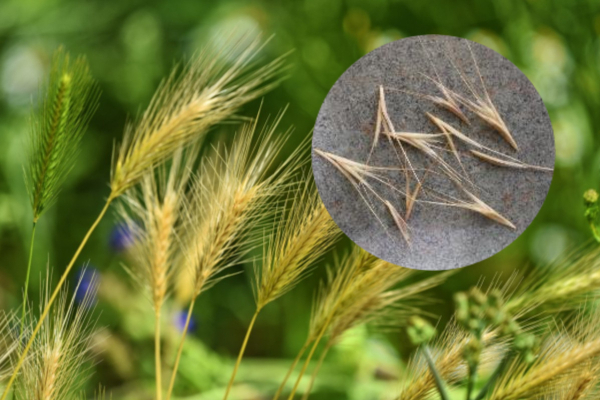During the past week, we’ve seen eight dogs with foxtail awns lodged between their toes. The seeds act like a large splinter that a body considers “foreign,” causing a very painful and infected abscess. Dogs come to see us limping, licking their feet, with a swollen, painful foot that’s often draining a bit of pus.
Not only do these prickly seeds cause pain when they enter the skin between toes, they’re also potentially dangerous to dogs and cats and can cause infection, chronic illness, and even death.
Identifying Foxtail
“Foxtail” refers to several species of tall, wild grasses common along the West Coast. They weren’t overly common in Seattle until the last two-to-three years, but we’re seeing a spike in patients presenting with them lodged in their bodies.
Foxtails commonly grow along roadsides, trails, and in grassland areas. In summer, as the plant begins to dry out, the seed heads become brittle and fall off the plant. Awns are shaped like arrowheads.

Each awn has a sharp point and several long bristles. Each bristle is covered with loads of microscopic barbs that act similar to a porcupine quill or fishhook, only allowing the seed to advance but not back up. When a dog or cat brushes by dry foxtail, or sniffs it, steps on it, or rolls on it, the barbs catch on the animal’s fur, feet, nose, or ears.
When a dog steps on foxtail, those nasty barbs embed themselves deep into the webbing between the toes, causing an abscess. The barbs can dig themselves into a patch of skin and then travel through tissue. Because these tough seeds can’t be absorbed by the body or digested, they cause pain and inflammation as they migrate through the body.
Foxtail barbs can also go up a nose, into an ear, behind an eyeball, and into the genitals.
- An awn lodged in a pet’s nasal passage can travel into the brain and cause seizures, and even death. Bring your pet in immediately if you notice frequent and intense sneezing or discharge from the nose.
- An awn in an ear can rupture the eardrum and cause chronic ear infections. If your pet is incessantly shaking its head, tilting it to one side, or scratching an ear, it could be a sign of foxtail embedded deep within the ear canal.
- An awn in an eye can lead to blindness. Seek veterinary care if you notice squinting, redness, swelling, discharge, or pawing at the eye.
- An awn in the genitals can be excruciatingly painful. Contact us if you notice your pet persistently licking its genitals.
- When a dog or cat inhales foxtail, the result can be a perforated lung or infections that require major surgery.
Minimizing Foxtail Risks
Obviously, the best way to minimize the risk of foxtail invasion is to avoid areas where foxtail grows. That’s not always easy to do in our area, where the weed grows like a… well… weed. When walking your dog, keep him on a leash and on the trail, to lessen the chances of our pet sniffing around foxtails.
If you have foxtails in your yard, dig them up by hand and dispose of them in the trash (not in yard waste or the compost heap, where the seeds may be spread to other yards).
After walking your pet, brush its coat and thoroughly examine between each toe, underneath the feet, in ears, armpit, groin, and anal area.
When to Seek Veterinary Care… and What to Expect
If you notice any suspicious lumps, swelling, excessive licking, head-shaking, or sneezing, contact us immediately. If we suspect a wound is caused by a foxtail awn, we will try to remove it by flushing and exploring the wound (this can be painful, and usually requires sedation).
Often we’re successful in finding the seed, which allows the body to heal. Sometimes the seed has traveled a good distance from where it entered the body (such as several inches up a leg from the toes where it entered).
Other times, we are not successful at finding the seed. In these situations, we may need to refer a pet to a veterinary surgeon who can use advanced imaging to try to find the seed’s track through the body so it can be removed.
As global warming changes our environment, threats to our pets are changing, from different species of parasites (dog ticks, deer ticks, Lyme disease, heart worms) to different species of plants (foxtails) and fungal infections.
We stay abreast of these changes and update our recommendations. Stay tuned here for timely updates as new information arrives.


